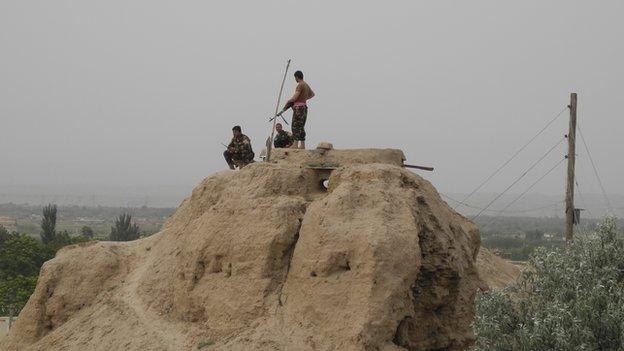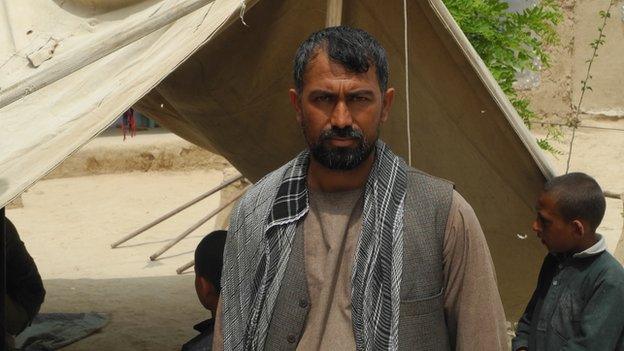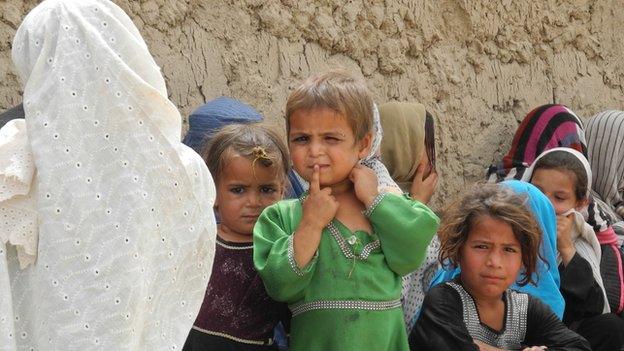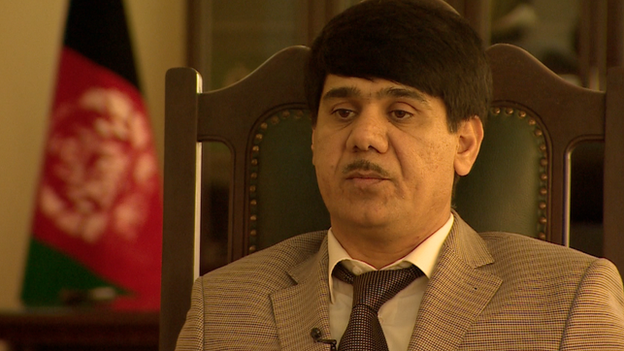Afghan conflict: Kunduz battle heralds Taliban-IS tie-up
- Published
The BBC's David Loyn says "a huge humanitarian crisis" is now unfolding in Kunduz
Fighting between government forces and the Taliban in the north-eastern Afghan province of Kunduz has displaced tens of thousands of people now living in temporary shelters. It has also raised questions about possible new co-operation by militant groups.
Until now, particularly in the south of the country, fighters from the self-proclaimed Islamic State group have often clashed with the Taliban.
But the governor of Kunduz, Mohammed Omer Safi, said the Taliban there had been joined by IS fighters.
This is the first positive confirmation by a senior government official that IS is operating alongside the Taliban in Afghanistan.

Government forces lack air power in the fight against militants

Mohammed Bahadur said his family was caught in the crossfire
The governor said that the battle for the north is different, and here IS fighters are "supporting the Taliban, training the Taliban, trying to build the capacity of the Taliban for a bigger fight". And he said they were more violent because they wanted to die in battle as martyrs.
The bodies of 18 foreign fighters found after recent fighting included two women. As well as those from Afghanistan's immediate northern neighbours, Tajikistan, Uzbekistan, and Kyrgyzstan, those killed came from Chechnya and Turkey.
They were wearing black headbands marked with the same Islamic verses used by IS in Syria and Iraq.
Taliban 'more violent'
It is a low-tech war being run from the ruins of an old hill fort in the provincial capital, a high vantage point from where the sounds of fighting can clearly be heard. Commanders issue orders mostly on mobile phones, attempting to keep the momentum of their counter-offensive.
The governor said Afghan forces did not have enough air power, and the helicopters they did have lacked the armaments that they should have. The international forces who remain in Afghanistan have turned down several requests to assist in a battle with Nato air strikes.

Displaced families are trying to rebuild lives in villages outside the provincial capital

Governor Safi says IS is supporting and training the Taliban
Some of those displaced have moved to villages they consider safe, where they are squatting in farmyards and trying to put their lives back together.
Constructing a shelter for his family from a large piece of canvas, Mohammed Bahadur said he fled with his family after they were caught in crossfire.
"From one side the government were firing, from the other side the Taliban. Our house was in between," he said.
His mother, who like many in the Afghan countryside does not have a name she uses outside her family, said the Taliban killed all their animals. She talked of them as the new Taliban - more violent than before - a description that would fit the intelligence view that IS fighters are operating here.
Some 10,000 families have been displaced by the fighting.
A huge humanitarian crisis is unfolding and those displaced complained that they will not be able to bring in the harvest.
The fertile land of Kunduz supplies half of Afghanistan's rice crop, so if the fighting goes on it could have a far-reaching impact beyond the lives affected here.
International agencies are responding, trying to find those displaced spread across a wide area of countryside.
The insurgents have been pushed back from houses they took in the outskirts of the provincial capital when they launched their offensive. But Kunduz remains surrounded by a determined enemy, as another fighting season gets under way in Afghanistan.